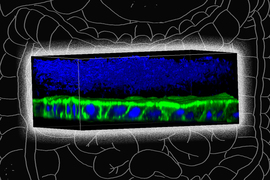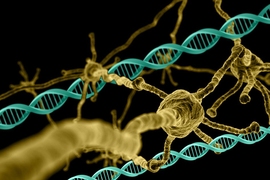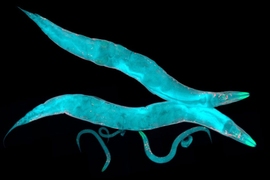The naked eye can barely spot the transparent nematodes at the center of PhD student Gurrein Madan’s neuroscience research. While C. elegans worms may initially seem an unassuming test subject for a graduate student who investigates the intricacies of gut-brain signaling, many of the genes found in C. elegans have counterparts in the human brain. Gurrein’s research could yield new insights into the gut-brain relationship, which may have practical health implications for humans.
Gurrein works in the lab of Steven Flavell, the Lister Brothers Career Development Assistant Professor in the Picower Institute for Learning and Memory and Department of Brain and Cognitive Sciences at MIT. There, researchers address some of neuroscience’s most essential questions, using C. elegans as a model. The lab centers around understanding how neuromodulatory systems — such as those cellular systems that release, and are stimulated by, serotonin — affect animal behavior. The millimeter-long C. elegans are an ideal model for this work because their nervous system, with just 302 neurons, has been well-characterized: “It is the only animal on the planet where there is a full blueprint of how all of its brain cells are wired together,” says Flavell. Combined with cutting-edge genetic and neural imaging technologies, the nematode model affords mechanistic studies of behavior from the scale of molecules to the whole brain.
Gurrein was recently named one of this year’s School of Science MathWorks Fellows. The fellowship is a one-year renewable opportunity for graduate students in the School of Science who use the software MATLAB to make impressive strides in their research. Funding for the fellowship is provided with support from MathWorks, founded by its president, John N. Little ’78. MATLAB is used extensively by faculty, students, and researchers across the world — and MIT’s campus — to develop algorithms, computations, and simulations.
Gurrein’s project specifically looks at the neurons that line the C. elegans gut. These enteric neurons detect food and respond to changes in the animal’s nutritional state while receiving feedback from other parts of the brain. Gurrein studies the class of neurons that release serotonin, which has a profound influence on the animal’s feeding behavior.
“Currently, we are investigating what receptors expressed in these enteric neurons regulate the neurons’ response to food, as well as to feedback from the rest of the nervous system,” Gurrein says. “By using genetics and neural imaging techniques, we attempt to uncover new molecular players involved in gut-brain signaling.”
Dysregulation of gut-brain signaling has been linked to psychiatric disorders, such as depression and autism spectrum disorder, in humans. Diverse molecules, including neurotransmitters and inflammatory molecules, mediate the two-way communication between the gut and the brain. However, the specific pathways behind this relationship are not well understood. Gurrein hopes to uncover more about the signaling mechanisms driving the connection.
“Much of our understanding of the fundamental pathways that control animal development and function comes from studies that originated in C. elegans, where basic genetic pathways were rapidly discovered,” says Flavell. “Lo and behold, in humans, the same pathways control the same cellular processes. Many of these pathways have then become targets for drug development to treat human disease.”
Using MATLAB at nearly every step of her research — from data collection and processing to analysis — Gurrein was an excellent candidate for the MathWorks fellowship. “I was excited to apply for two reasons. First, the fellowship was open to international students. Typically, international students are ineligible to apply to most fellowships out there. Second, MATLAB serves as the critical platform for comprehensively handling my data,” Gurrein says.
Gurrein grew up in Amritsar in northwest India. Early in high school, Gurrein was placed in the sciences track, and upon graduation traveled to the United States for her undergraduate degree. During her sophomore year at Swarthmore College, she began research in a neurobiology lab and quickly realized how much she enjoyed the process of conducting scientific research. Moreover, she found the interdisciplinary nature of the neuroscience field exciting. After graduating with a BA in neuroscience in 2017, she immediately began her PhD at MIT.
“I really like the innovative aspect of a PhD,” Gurrein says. “We are trained to expand the limits of what is known in our fields by being persistent, constantly troubleshooting, and coming up with new approaches to probe a question. I was initially considering medical school, but my research experiences led me to think that a PhD was probably a better fit for me.”
Gurrein’s colleagues noticed her enthusiasm for scientific discovery immediately. Flavell says she impressed him “right out of the gate.” Within her first six months in the lab, Gurrein was instrumental in designing new experiments, conducting behavioral assays, and making notable discoveries that made their way into publications.
“Gurrein has an enormous amount of drive and energy, always trying her best to make impactful discoveries,” says Flavell. “We have meetings once a week, and she always brings a critical eye to her own work, thinking about her datasets, what they mean, and how they give rise to new research directions. She wants to make sure the data she gets is really convincing and setting her on a path to making a true discovery.”
“The general topic of how the gut is influencing the brain is a relatively new field,” Gurrein says. “I think there is a lot of space for novel, exciting contributions.”





!["[W]e hope that our studies of vps-50 will provide insights into human neuropsychiatric disorders,” H. Robert Horvitz says.](/sites/default/files/styles/news_article__archive/public/images/201603/MIT-BehavorialStates.jpg?itok=KbSrJbQQ)





